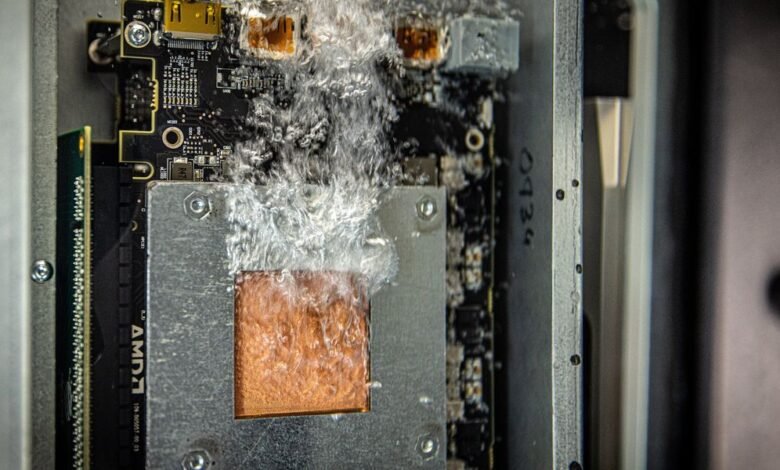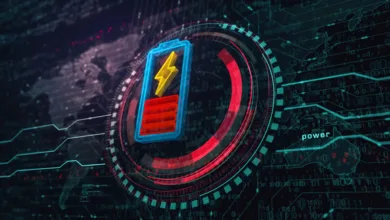Cool Your AI: The Rise of Liquid Data Centers

▼ Summary
– Traditional air cooling with fans is becoming inadequate for data centers due to rapidly increasing chip power densities driven by AI demands.
– Liquid cooling is emerging as the necessary solution because liquids like water can absorb and transfer heat far more effectively than air.
– Single-phase direct-to-chip cooling uses water or glycol-water mixtures circulated through cold plates on the hottest chips, but it often requires hybrid systems with air cooling for less dense components.
– Two-phase direct-to-chip cooling employs dielectric fluids that boil on contact with chips, using latent heat for efficient cooling and allowing higher facility water temperatures for energy savings.
– Immersion cooling methods, including single-phase and two-phase, submerge entire servers in dielectric fluids, offering comprehensive cooling but facing challenges like equipment maintenance and fluid evaporation.
The relentless growth of artificial intelligence is pushing data center cooling technology to its absolute limits. Traditional air cooling, with its familiar roar of countless fans, simply cannot manage the immense thermal output generated by today’s advanced AI chips. The power consumption of these processors has skyrocketed, with the latest models drawing over a kilowatt each, and projections point to chips requiring multiple kilowatts in the near future. This thermal crisis is forcing a fundamental shift away from moving air and toward a more potent medium: liquid.
Liquids possess a remarkable capacity for heat absorption. Water, for instance, can soak up thousands of times more thermal energy than an equivalent volume of air. This superior thermal conductivity is why a brief touch with boiling water causes severe injury, while reaching into a hot oven is often harmless. The heat transfers with stunning speed. Industry leaders now widely acknowledge that liquid cooling is the definitive path forward for AI data centers, where rack power densities are leaping from an average of 8 kW to a staggering 100 kW.
The implementation of liquid cooling, however, is not a one-size-fits-all proposition. Several distinct methods are currently vying for dominance, each with unique advantages and complexities.
Direct-to-Chip Cooling with a Single Liquid Phase
The most established technique involves placing metal cold plates directly onto the hottest components, like GPUs and CPUs. A chilled mixture of water and glycol circulates through channels within these plates, drawing heat away at the source. This coolant travels in a closed loop to a heat exchanger, where facility water cools it down before it returns to the chips. This hybrid approach often handles about 80 percent of a server’s cooling, leaving less demanding components to be managed by traditional air systems.
Two-Phase Direct-to-Chip Cooling
As chip power continues its upward climb, a more advanced method leverages the physics of phase change. Here, a specially formulated dielectric fluid circulates through cold plates. Upon contacting the hot chip, the fluid boils, transforming into a vapor. This phase change absorbs a massive amount of latent heat without a significant temperature increase. The vapor is then condensed back into a liquid by a heat exchanger. Because the boiling process is so efficient, the facility water can be several degrees warmer than in single-phase systems, leading to major energy savings. This method also requires much lower fluid flow rates, reducing pumping energy and wear on the system.
Single-Phase Immersion Cooling
This approach bypasses cold plates entirely by submerging entire servers into tanks filled with a dielectric oil. Every component is cooled uniformly by the fluid, which is then itself cooled by heat exchangers immersed in the tank. This creates a pristine operating environment free from dust, vibration, and fan noise. While effective for many systems, the very highest-power chips can still overwhelm the relatively slow-moving oil, sometimes necessitating the addition of cold plates for targeted, enhanced cooling.
Two-Phase Immersion Cooling
The most ambitious technique combines immersion with boiling. Servers are fully submerged in a tank of dielectric fluid engineered to boil directly on the surfaces of hot components. The resulting vapor rises, contacts a condenser cooled by facility water, and drips back down as a liquid. This cycle offers a colossal cooling capacity, thanks to the latent heat of vaporization, and can eliminate the need for energy-intensive chillers in many climates. While critics point to challenges like fluid cost and maintenance complexity, proponents see it as the ultimate solution, especially as other components like memory and power supplies also begin to require liquid cooling.
The financial case for these advanced methods is strengthening. Analyses suggest that two-phase immersion cooling can be more cost-effective over a decade than other liquid techniques, primarily due to lower power consumption and simplified infrastructure. The industry consensus is clear: the heat problem must be solved. As AI hardware grows ever more powerful, the race to perfect liquid cooling is not just a market opportunity; it represents one of the most critical and engaging engineering challenges in modern computing.
(Source: Spectrum)





